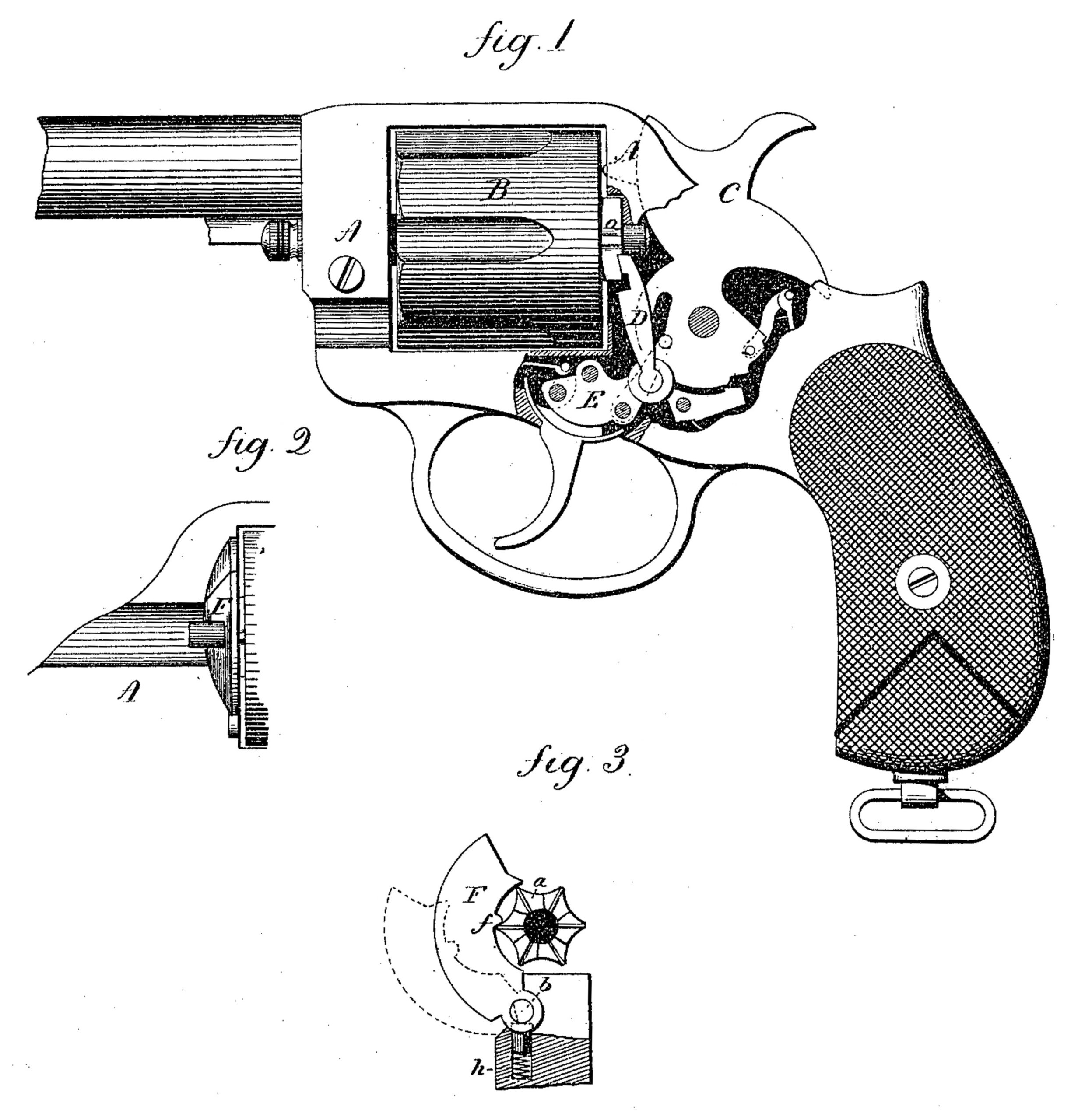US 247374
UNITED STATES PATENT OFFICE.
WILLIAM MASON, OF HARTFORD, CONNECTICUT, ASSIGNOR TO THE COLT’S PATENT FIRE-ARMS MANUFACTURING COMPANY, OF SAME PLACE.
REVOLVING FIRE-ARM.
SPECIFICATION forming part of Letters Patent No. 247,374, dated September 20, 1881.
Application filed June 29, 1881. (No Model.)
To all whom it may concern:
Be it known that I, WM. MASON, of Hartford, in the county of Hartford and State of Connecticut, have invented new Improvement in Revolvers; and I do hereby declare the following, when take it connection with the accompanying drawings and letters of reference marked thereon, to be a full, clear, and exact description of the same, and which said drawings constitute part of this specification, and represent, in–
Figure 1, a sectional side view; Fig. 2, a partial opposite side view; Fig. 3, a transverse section, immediately in rear of the cylinder, looking toward the rear.
This invention relates to an improvement in that class of revolvers which are made self-cocking, in which the cylinder is rotated by the cocking of the hammer or pulling of the trigger.
In this class of pistols it is necessary to provide a lock or catch which will engage the cylinder after its rotation and before the hammer is discharged or the trigger released, because the pawl which rotates the cylinder unavoidably drags over the ratchet as it returns for a new engagement, and unless the cylinder be locked the friction of the pawl dragging over the ratchet will turn the cylinder backward to such an extent that the next advance of the pawl will not take engagement with the ratchet of the cylinder; hence the cylinder would not be rotated at that next pull.
Various devices have been employed to lock the cylinder at the proper time, but all are more or less complicated, and so frequently become disarranged as to take the make the action of the arm uncertain.
To overcome this difficulty is the object of this invention; at it consists in employing the gate, which opens or closes the the rear end of the cylinder for the insertion of cartridges, as a pawl to engage the cylinder after each rotative movement, and before the pawl which rotates the cylinder returns, as more fully hereinafter described.
A is the frame or receiver; B, the cylinder, provided with a ratchet, a, at the rear end; C, the hammer; D, the pawl, which is connected, as here represented, to an intermediate lever, E, all of substantially known construction, and which need no further description in this specification than to say that the pulling of the trigger, in the act of cocking the hammer, brings the pawl into active connection with the ratchet, so that as the pawl rises it turns the ratchet and cylinder in the usual manner.
On the right-hand side of the receiver is the gate F, arranged upon a pivot, b, and so as to be turned away in a vertical plane to expose the rear end of one or more chambers for the insertion of cartridges, as seen in Fig. 3. This construction or arrangement of gate is substantially that seen in Letters Patent granted to me, January 19, 1875, No. 158,957. The inner edge of this gate, when closed, lies near the periphery of the ratchet a. At some point in the inner edge of the gate I make a tooth or inward projection, f, (see Fig. 3,) which will extend into the path of the teeth of the rotating ratchet. The gate F is provided with a spring, h, as seen in Fig. 3, which acts to hold it there in its open or closed position, and to serve to bear it toward its closed position and permit it to be moved slightly away from that position and automatically returned when released, substantially as in my patent before referred to; hence the teeth of the pawl pass the tooth f on the gate in the movement of rotating the cylinder, which will force the gate away so is to permit the teeth of the ratchet to pass the tooth f; then the gate will be returned by the force of its spring and come upon the opposite side of the tooth, as seen in Fig. 3, and thus serve as a stop to prevent the return or backward movement of the cylinder when the pawl drags down for a new hold. No change in construction is required for this arrangement, the only addition being simply the tooth f on the gate. There is therefore no additional mechanism applied to the arm to lock or stop the cylinder; it is effectively done, and cannot get out of order.
I claim–
In a revolver, the combination of the ratchet on the cylinder, and the pawl for operating the same, with the gate which opens and closes the chambers of the cylinder for the insertion or ejection of cartridges, constructed with a tooth to engage a corresponding tooth on the rachet after each advance rotative movement of the cylinder, substantially as described.
WILLIAM MASON.
Witnesses:
E. F. BODWELL,
ROBERT KANE.

